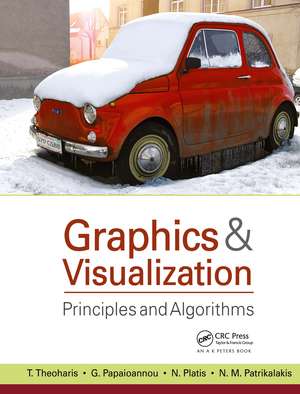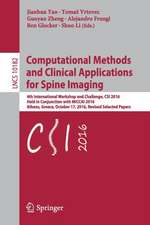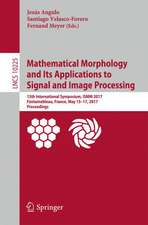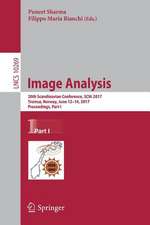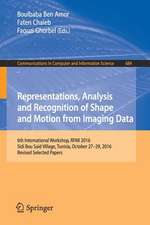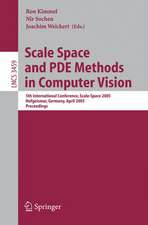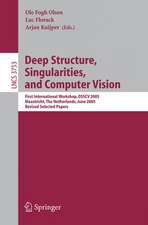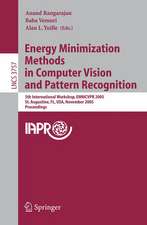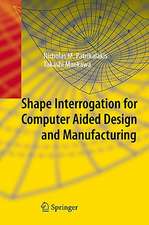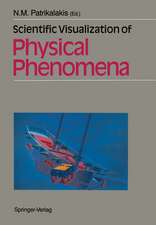Graphics and Visualization: Principles & Algorithms
Autor T. Theoharis, Georgios Papaioannou, Nikolaos Platis, Nicholas M. Patrikalakisen Limba Engleză Hardback – 5 iul 2021
Preț: 502.51 lei
Preț vechi: 690.52 lei
-27% Nou
Puncte Express: 754
Preț estimativ în valută:
96.19€ • 104.51$ • 80.85£
96.19€ • 104.51$ • 80.85£
Carte tipărită la comandă
Livrare economică 21 aprilie-05 mai
Preluare comenzi: 021 569.72.76
Specificații
ISBN-13: 9781568812748
ISBN-10: 1568812744
Pagini: 800
Dimensiuni: 189 x 246 x 46 mm
Greutate: 1.38 kg
Ediția:1
Editura: CRC Press
Colecția A K Peters/CRC Press
ISBN-10: 1568812744
Pagini: 800
Dimensiuni: 189 x 246 x 46 mm
Greutate: 1.38 kg
Ediția:1
Editura: CRC Press
Colecția A K Peters/CRC Press
Recenzii
Computer and engineering collections strong in applied graphics and analysis of visual data via computer will find Graphics & Visualization: Principles and Algorithms makes an excellent classroom text as well as supplemental reading. It integrates coverage of computer graphics and other visualization topics, from shadow geneeration and particle tracing to spatial subdivision and vector data visualization, and it provides a thorough review of literature from multiple experts, making for a comprehensive review essential to any advanced computer study.
—California Bookwatch, November 2008
The author's writing style is crisp, direct, and effective, and they start at an appropriate level of introduction for students new to computer graphics. The mathematical notation they use is efficient and consistent with that used in other undergraduate textbooks. There's a point at which additional examples unduly bloat a text, but the authors achieve an effective balance with the ones they've chosen to include. This is the most apparent in the chapter on 2D and 3D coordinates systems and transformations, which also includes a good section of exercises for all topics. ... On the whole, the authors have produced an excellent text with good coverage of essential topics and advanced treatment in many areas. In courses not emphasizing animation, or with the addition of extra materials in this area, the book should provide a good option as a course textbook. For researchers and practitioners outside of computer graphics who are interested in the field (particularly in modeling and rendering), this book provides a fine introduction.
—Russell A. and Holly E. Rushmeier, Computing Now Book Reviews, April 2009
—California Bookwatch, November 2008
The author's writing style is crisp, direct, and effective, and they start at an appropriate level of introduction for students new to computer graphics. The mathematical notation they use is efficient and consistent with that used in other undergraduate textbooks. There's a point at which additional examples unduly bloat a text, but the authors achieve an effective balance with the ones they've chosen to include. This is the most apparent in the chapter on 2D and 3D coordinates systems and transformations, which also includes a good section of exercises for all topics. ... On the whole, the authors have produced an excellent text with good coverage of essential topics and advanced treatment in many areas. In courses not emphasizing animation, or with the addition of extra materials in this area, the book should provide a good option as a course textbook. For researchers and practitioners outside of computer graphics who are interested in the field (particularly in modeling and rendering), this book provides a fine introduction.
—Russell A. and Holly E. Rushmeier, Computing Now Book Reviews, April 2009
Notă biografică
T. Theoharis, Georgios Papaioannou, Nikolaos Platis, Nicholas M. Patrikalakis
Cuprins
Preface, 1 Introduction, 2 Rasterization Algorithms, 3 2D and 3D Coordinate Systems and Transformations, 4 Projections and Viewing Transformations, 5 Culling and Hidden Surface Elimination Algorithms, 6 Model Representation and Simplification, 7 Parametric Curves and Surfaces, 8 Subdivision for Graphics and Visualization, 9 Scene Management, 10 Visualization Principles, 11 Color in Graphics and Visualization, 12 Illumination Models and Algorithms, 13 Shadows, 14 Texturing, 15 Ray Tracing, 16 Global Illumination Algorithms, 17 Basic Animation Techniques, 18 Scientific Visualization Algorithms, A Vector and Affine Spaces, B Differential Geometry Basics, C Intersection Tests, D Solid Angle Calculations, E Elements of Signal Theory, Bibliography, Index
Descriere
This book is a comprehensive introduction to visual computing, dealing with the modeling and synthesis of visual data by means of computers. What sets this book apart from other computer graphics texts is the integrated coverage of computer graphics and visualization topics, including important techniques such as subdivision and multi-resolution modeling, scene graphs, shadow generation, ambient occlusion, and scalar and vector data visualization. Students and practitioners will benefit from the comprehensive coverage of the principles that are the basic tools of their trade, from fundamental computer graphics and classic visualization techniques to advanced topics.
